Improved Decision Tree
Papers and Code
SPOT: Scalable Policy Optimization with Trees for Markov Decision Processes
Oct 22, 2025Interpretable reinforcement learning policies are essential for high-stakes decision-making, yet optimizing decision tree policies in Markov Decision Processes (MDPs) remains challenging. We propose SPOT, a novel method for computing decision tree policies, which formulates the optimization problem as a mixed-integer linear program (MILP). To enhance efficiency, we employ a reduced-space branch-and-bound approach that decouples the MDP dynamics from tree-structure constraints, enabling efficient parallel search. This significantly improves runtime and scalability compared to previous methods. Our approach ensures that each iteration yields the optimal decision tree. Experimental results on standard benchmarks demonstrate that SPOT achieves substantial speedup and scales to larger MDPs with a significantly higher number of states. The resulting decision tree policies are interpretable and compact, maintaining transparency without compromising performance. These results demonstrate that our approach simultaneously achieves interpretability and scalability, delivering high-quality policies an order of magnitude faster than existing approaches.
Interpret Policies in Deep Reinforcement Learning using SILVER with RL-Guided Labeling: A Model-level Approach to High-dimensional and Multi-action Environments
Oct 22, 2025Deep reinforcement learning (RL) achieves remarkable performance but lacks interpretability, limiting trust in policy behavior. The existing SILVER framework (Li, Siddique, and Cao 2025) explains RL policy via Shapley-based regression but remains restricted to low-dimensional, binary-action domains. We propose SILVER with RL-guided labeling, an enhanced variant that extends SILVER to multi-action and high-dimensional environments by incorporating the RL policy's own action outputs into the boundary points identification. Our method first extracts compact feature representations from image observations, performs SHAP-based feature attribution, and then employs RL-guided labeling to generate behaviorally consistent boundary datasets. Surrogate models, such as decision trees and regression-based functions, are subsequently trained to interpret RL policy's decision structure. We evaluate the proposed framework on two Atari environments using three deep RL algorithms and conduct human-subject study to assess the clarity and trustworthiness of the derived interpretable policy. Results show that our approach maintains competitive task performance while substantially improving transparency and human understanding of agent behavior. This work advances explainable RL by transforming SILVER into a scalable and behavior-aware framework for interpreting deep RL agents in high-dimensional, multi-action settings.
Improving Decision Trees through the Lens of Parameterized Local Search
Oct 14, 2025
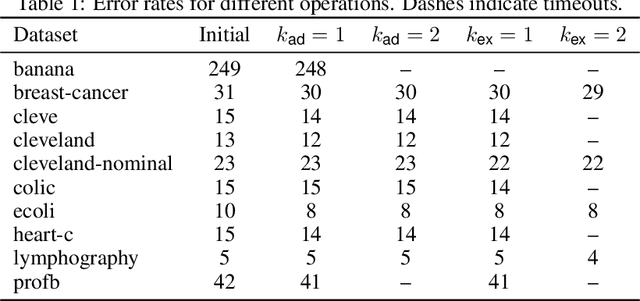
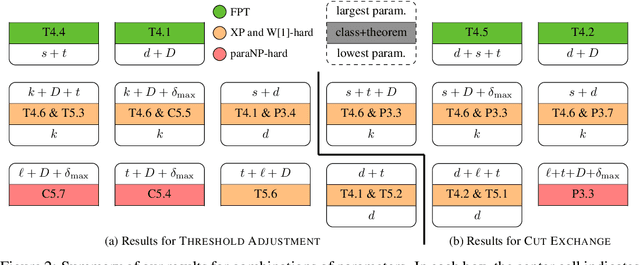
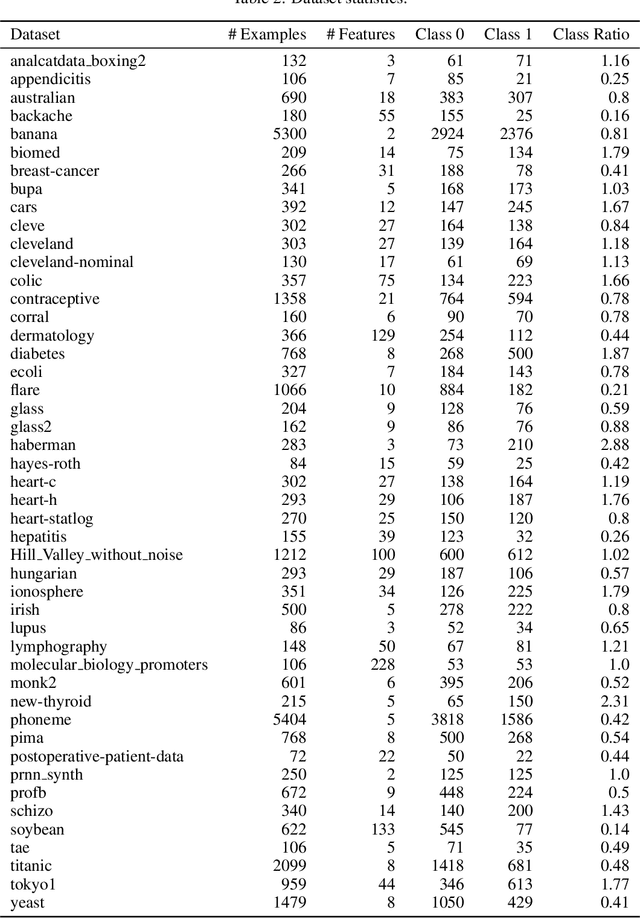
Algorithms for learning decision trees often include heuristic local-search operations such as (1) adjusting the threshold of a cut or (2) also exchanging the feature of that cut. We study minimizing the number of classification errors by performing a fixed number of a single type of these operations. Although we discover that the corresponding problems are NP-complete in general, we provide a comprehensive parameterized-complexity analysis with the aim of determining those properties of the problems that explain the hardness and those that make the problems tractable. For instance, we show that the problems remain hard for a small number $d$ of features or small domain size $D$ but the combination of both yields fixed-parameter tractability. That is, the problems are solvable in $(D + 1)^{2d} \cdot |I|^{O(1)}$ time, where $|I|$ is the size of the input. We also provide a proof-of-concept implementation of this algorithm and report on empirical results.
Comparison of Machine Learning Models to Classify Documents on Digital Development
Oct 02, 2025Automated document classification is a trending topic in Natural Language Processing (NLP) due to the extensive growth in digital databases. However, a model that fits well for a specific classification task might perform weakly for another dataset due to differences in the context. Thus, training and evaluating several models is necessary to optimise the results. This study employs a publicly available document database on worldwide digital development interventions categorised under twelve areas. Since digital interventions are still emerging, utilising NLP in the field is relatively new. Given the exponential growth of digital interventions, this research has a vast scope for improving how digital-development-oriented organisations report their work. The paper examines the classification performance of Machine Learning (ML) algorithms, including Decision Trees, k-Nearest Neighbors, Support Vector Machine, AdaBoost, Stochastic Gradient Descent, Naive Bayes, and Logistic Regression. Accuracy, precision, recall and F1-score are utilised to evaluate the performance of these models, while oversampling is used to address the class-imbalanced nature of the dataset. Deviating from the traditional approach of fitting a single model for multiclass classification, this paper investigates the One vs Rest approach to build a combined model that optimises the performance. The study concludes that the amount of data is not the sole factor affecting the performance; features like similarity within classes and dissimilarity among classes are also crucial.
* 16 pages, 4 figures, 4 tables, presented at First International Conference, DSAI 2023, Bangkok
Natural Language Edge Labelling: Decoupling Intent from Execution in Structured LM Reasoning
Oct 06, 2025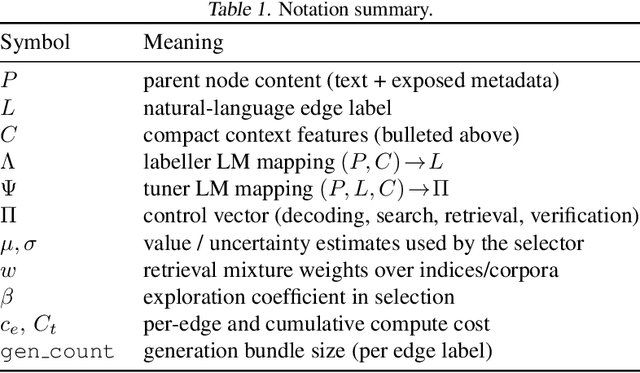
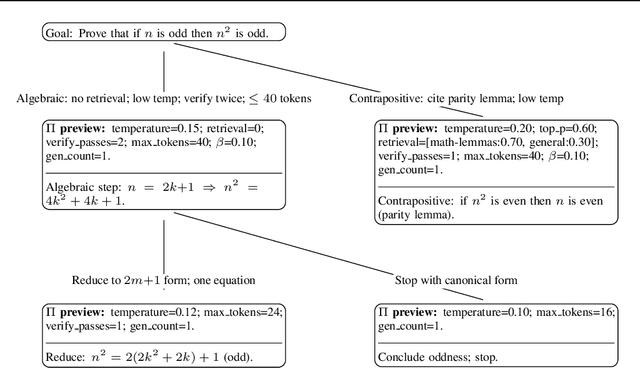


Controllers for structured LM reasoning (e.g., Chain-of-Thought, self-consistency, and Tree-of-Thoughts) often entangle what to try next with how to execute it, exposing only coarse global knobs and yielding brittle, compute-inefficient, and hard-to-audit behavior. We introduce Natural Language Edge Labelling (NLEL), a labeller-tuner overlay that attaches a free-form natural-language directive to each search edge and translates it into a schema-bounded control vector for decoding, search (branch quotas, exploration $\beta$), generation bundle size, retrieval mixtures, and verification passes. A labeller $\Lambda$ emits labels from the parent state and a compact context; a tuner $\Psi$ maps $(P, L, C)\to \Pi$, with strict schema validation and trust-region projection around safe defaults. Downstream selection remains ToT-style with score $S=\mu+\beta\sigma$ and depth-annealed $\beta$. We show NLEL strictly generalizes CoT/ToT, prove an anytime-monotonicity property for top-$k$ selection under label-conditioned bundles, and bound selector shortfall by control-vector distortion, providing decision-relevant justification for guards like trust regions and verification passes. We instantiate $\Psi$ as a prompt-only JSON Parameter Emitter and preregister an evaluation on GSM8K, MATH (subset), StrategyQA, and ARC-Challenge with compute-aware reporting (success@compute, tokens-per-success) and ablations over $\Lambda$, $\Psi$, trust-region radius, and control quantization; preregistered forecasts anticipate accuracy gains at comparable token budgets and improved success@compute under constraints. NLEL offers an interpretable, model-agnostic interface that separates intent from execution for controllable, auditable LM inference.
Plan Then Action:High-Level Planning Guidance Reinforcement Learning for LLM Reasoning
Oct 02, 2025Large language models (LLMs) have demonstrated remarkable reasoning abilities in complex tasks, often relying on Chain-of-Thought (CoT) reasoning. However, due to their autoregressive token-level generation, the reasoning process is largely constrained to local decision-making and lacks global planning. This limitation frequently results in redundant, incoherent, or inaccurate reasoning, which significantly degrades overall performance. Existing approaches, such as tree-based algorithms and reinforcement learning (RL), attempt to address this issue but suffer from high computational costs and often fail to produce optimal reasoning trajectories. To tackle this challenge, we propose Plan-Then-Action Enhanced Reasoning with Group Relative Policy Optimization PTA-GRPO, a two-stage framework designed to improve both high-level planning and fine-grained CoT reasoning. In the first stage, we leverage advanced LLMs to distill CoT into compact high-level guidance, which is then used for supervised fine-tuning (SFT). In the second stage, we introduce a guidance-aware RL method that jointly optimizes the final output and the quality of high-level guidance, thereby enhancing reasoning effectiveness. We conduct extensive experiments on multiple mathematical reasoning benchmarks, including MATH, AIME2024, AIME2025, and AMC, across diverse base models such as Qwen2.5-7B-Instruct, Qwen3-8B, Qwen3-14B, and LLaMA3.2-3B. Experimental results demonstrate that PTA-GRPO consistently achieves stable and significant improvements across different models and tasks, validating its effectiveness and generalization.
DyRo-MCTS: A Robust Monte Carlo Tree Search Approach to Dynamic Job Shop Scheduling
Sep 26, 2025Dynamic job shop scheduling, a fundamental combinatorial optimisation problem in various industrial sectors, poses substantial challenges for effective scheduling due to frequent disruptions caused by the arrival of new jobs. State-of-the-art methods employ machine learning to learn scheduling policies offline, enabling rapid responses to dynamic events. However, these offline policies are often imperfect, necessitating the use of planning techniques such as Monte Carlo Tree Search (MCTS) to improve performance at online decision time. The unpredictability of new job arrivals complicates online planning, as decisions based on incomplete problem information are vulnerable to disturbances. To address this issue, we propose the Dynamic Robust MCTS (DyRo-MCTS) approach, which integrates action robustness estimation into MCTS. DyRo-MCTS guides the production environment toward states that not only yield good scheduling outcomes but are also easily adaptable to future job arrivals. Extensive experiments show that DyRo-MCTS significantly improves the performance of offline-learned policies with negligible additional online planning time. Moreover, DyRo-MCTS consistently outperforms vanilla MCTS across various scheduling scenarios. Further analysis reveals that its ability to make robust scheduling decisions leads to long-term, sustainable performance gains under disturbances.
Think Socially via Cognitive Reasoning
Sep 26, 2025LLMs trained for logical reasoning excel at step-by-step deduction to reach verifiable answers. However, this paradigm is ill-suited for navigating social situations, which induce an interpretive process of analyzing ambiguous cues that rarely yield a definitive outcome. To bridge this gap, we introduce Cognitive Reasoning, a paradigm modeled on human social cognition. It formulates the interpretive process into a structured cognitive flow of interconnected cognitive units (e.g., observation or attribution), which combine adaptively to enable effective social thinking and responses. We then propose CogFlow, a complete framework that instills this capability in LLMs. CogFlow first curates a dataset of cognitive flows by simulating the associative and progressive nature of human thought via tree-structured planning. After instilling the basic cognitive reasoning capability via supervised fine-tuning, CogFlow adopts reinforcement learning to enable the model to improve itself via trial and error, guided by a multi-objective reward that optimizes both cognitive flow and response quality. Extensive experiments show that CogFlow effectively enhances the social cognitive capabilities of LLMs, and even humans, leading to more effective social decision-making.
General Demographic Foundation Models for Enhancing Predictive Performance Across Diseases
Sep 09, 2025Demographic attributes are universally present in electronic health records and serve as vital predictors in clinical risk stratification and treatment decisions. Despite their significance, these attributes are often relegated to auxiliary roles in model design, with limited attention has been given to learning their representations. This study proposes a General Demographic Pre-trained (GDP) model as a foundational representation framework tailored to age and gender. The model is pre-trained and evaluated using datasets with diverse diseases and population compositions from different geographic regions. The GDP architecture explores combinations of ordering strategies and encoding methods to transform tabular demographic inputs into latent embeddings. Experimental results demonstrate that sequential ordering substantially improves model performance in discrimination, calibration, and the corresponding information gain at each decision tree split, particularly in diseases where age and gender contribute significantly to risk stratification. Even in datasets where demographic attributes hold relatively low predictive value, GDP enhances the representational importance, increasing their influence in downstream gradient boosting models. The findings suggest that foundational models for tabular demographic attributes can generalize across tasks and populations, offering a promising direction for improving predictive performance in healthcare applications.
L-XAIDS: A LIME-based eXplainable AI framework for Intrusion Detection Systems
Aug 24, 2025Recent developments in Artificial Intelligence (AI) and their applications in critical industries such as healthcare, fin-tech and cybersecurity have led to a surge in research in explainability in AI. Innovative research methods are being explored to extract meaningful insight from blackbox AI systems to make the decision-making technology transparent and interpretable. Explainability becomes all the more critical when AI is used in decision making in domains like fintech, healthcare and safety critical systems such as cybersecurity and autonomous vehicles. However, there is still ambiguity lingering on the reliable evaluations for the users and nature of transparency in the explanations provided for the decisions made by black-boxed AI. To solve the blackbox nature of Machine Learning based Intrusion Detection Systems, a framework is proposed in this paper to give an explanation for IDSs decision making. This framework uses Local Interpretable Model-Agnostic Explanations (LIME) coupled with Explain Like I'm five (ELI5) and Decision Tree algorithms to provide local and global explanations and improve the interpretation of IDSs. The local explanations provide the justification for the decision made on a specific input. Whereas, the global explanations provides the list of significant features and their relationship with attack traffic. In addition, this framework brings transparency in the field of ML driven IDS that might be highly significant for wide scale adoption of eXplainable AI in cyber-critical systems. Our framework is able to achieve 85 percent accuracy in classifying attack behaviour on UNSW-NB15 dataset, while at the same time displaying the feature significance ranking of the top 10 features used in the classification.
 Add to Chrome
Add to Chrome Add to Firefox
Add to Firefox Add to Edge
Add to Edge